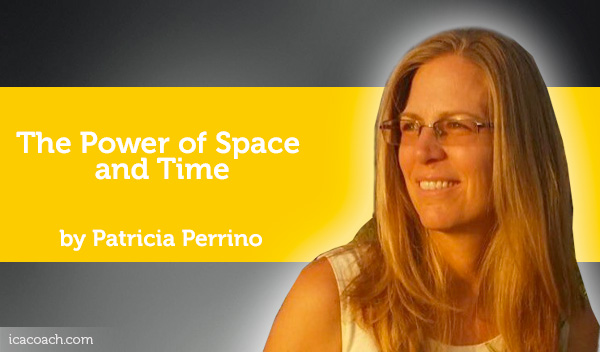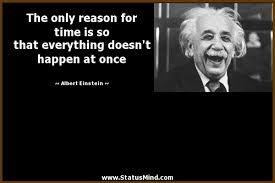
A Coaching Power Tool Created by Patricia Perrino
(Business Coach, UNITED STATES)
Creating space and time is one of the most powerful tools you can use in coaching. The Merriam-Webster dictionary defines space-time as,
the whole or a portion of physical reality determinable by a usually four-dimensional coordinate system.
Although you cannot necessarily see space and time, you can create it for yourself and your client throughout the session. When we engage a client, schedule a coaching session, and come together at the agreed upon time, we have created the so intangible, yet so important space and time for a most important meeting. Both the client and coach have prepared, consciously or not, and have invested their time for the session. Let us explore this space over our time together…
Space
Creating space in a coaching session context applies to both physical and mental space. It spans pre-session, during the session, and post-session. Pre-session, creating space includes clearing our minds of “clutter”. Consciously recognize and deal with thoughts until we feel spacious, centered, open, and fully aware and present. In this pre-session space, we plug in our active listening ears as we turn off the ‘voices in our heads’. We attend to our physical needs and take a deep cleansing breath to release and integrate it all together. We can prepare our physical space by ensuring it is comfortable and clear of distractions. Create a physical space that sets you up for success, whatever that is for you. During the session, consciously create “space” and keep this space through pauses as well as ensuring space is not overlapped by two people talking at once. After the session, create space again by documenting session notes, your thoughts, and taking that cleansing deep breath as you close the space to your valuable session. Creating, keeping, and closing space can be a powerful tool throughout the coaching session.
Personal Application
Take the time right now to look around you or move to the location you conduct coaching sessions. Make a list or arrange the space so that it makes you feel relaxed, spacious, comfortable, open, alert, and confident. Remove distractions and anything that is not inspiring. Ensure the physical space you create for your coaching session supports and enhances you and your client.
Now move to your mental space. Consciously prepare yourself for your coaching session. You may want to document or review your model or notes on the client. Take care of the ‘left brain’ or analytical side of the mental preparation until you feel complete. Prepare the ‘right brain’ by closing your eyes and taking some clearing deep breaths, noting anything on your mind that may be holding your attention or holding you back. Jot them down if you want to deal with them later or simply let them go. Envision the overall session going well with happy, satisfied faces at the end but not getting into detail. How does that feel? Do you feel spacious?
Coaching Application
You can apply the personal application before any or all coaching sessions. In the coaching session when you establish the relationship and review the confidentiality, consider creating an expansive space by inviting the client to take some deep, cleansing breaths with you to let go of all that came before and create clear space for both of you to give your full attention to the here and now of this precious time. Throughout the session, continue to create space by actively listening, pausing, allow for processing time, and even quiet time for you both to just be. After the session, close the space by taking notes to clearing your “headspace”, attend to any physical needs you have or stand or stretch or take a walk and finally fix your physical space if you need. Hopefully you and your client will feel it was a valuable use of time.
Time
Time. What a precious commodity it has become. It is so valuable to people.
 The time you spent preparing for a session, including everything that brought you to that moment including your education and experiences is not to be taken lightly. The time your client spent preparing for a session and all of their education and experiences up until that moment is worth acknowledging as well. Consider, with gratitude, the time both of your families and/or surrounding supporters spent to support this coaching session. We may not reflect on the scope of the preparation time. Both the client and coach agree on a certain date and time. That process itself can be time consuming. How about the time it takes to get to the session? Ensuring you are on time is important. Make the time, take your time, it’s time for action! When the time comes for the coaching session….wow, the magic begins! Continuing with the time factors during the session, watch your time. Prepare to note the time you begin and how you will manage watching your time throughout. Finally, acknowledging when the time of this special meeting is coming to a close. Use tact in that approach and even validate with a recurring client that the closing works for them. Logistically, you may schedule the next session date and time.
The time you spent preparing for a session, including everything that brought you to that moment including your education and experiences is not to be taken lightly. The time your client spent preparing for a session and all of their education and experiences up until that moment is worth acknowledging as well. Consider, with gratitude, the time both of your families and/or surrounding supporters spent to support this coaching session. We may not reflect on the scope of the preparation time. Both the client and coach agree on a certain date and time. That process itself can be time consuming. How about the time it takes to get to the session? Ensuring you are on time is important. Make the time, take your time, it’s time for action! When the time comes for the coaching session….wow, the magic begins! Continuing with the time factors during the session, watch your time. Prepare to note the time you begin and how you will manage watching your time throughout. Finally, acknowledging when the time of this special meeting is coming to a close. Use tact in that approach and even validate with a recurring client that the closing works for them. Logistically, you may schedule the next session date and time.
Personal Application
Consider your time.
What time is best for you to offer coaching sessions? Consider your biological time clock, the time of day that works best for you. Are you most alert in the morning, afternoon, or evenings? How about your schedule and other responsibilities? Time helps us with setting our priorities. Review your priorities and time. Are you comfortable where coaching fits in with your priorities and time? If you had all the time in the world, when would you offer coaching sessions? What can you arrange to create this best time for yourself when it comes to coaching? Honor your time and you will bring that much more service to your clients.
Coaching Application
It is the coach’s responsibility to watch the time during the session. Set yourself up for success with a method and how it fits in with the model you are applying for the session so you get in a rhythm and not have to watch the time. If you notice you tend to go over time often, review your sessions and identify ways to keep to the agreed upon time.
Keeping to the agreed upon time brings more value to yourself and the client. Either or both parties may have plans after or may start to lose attention which can lessen the impact of the session. If you have a long-time client, pay attention to the impact of time. Note the length of the session, the attention span of the client, and discuss if the client would be serviced better by a different time arrangement.
There are vast considerations to space and time in coaching. Use space and time as a tool in every coaching session. It can be the intangible foundation that yields a remarkable coaching session. Creation of deep space and the illusion of infinite time places space and time in the category of a power tool.
Reflections
What was something you did not consider or ‘connect the dots’ before this reading?
What do you do to create space and time for your coaching session?
How can you ensure the ‘stars align’ for you and your client using space and time in your coaching session?